Seven Ways a Warming Climate Can Kill the Southern Boreal Forest
Abstract
1. Introduction
2. Mechanisms Transforming Boreal Forest Vegetation in a Warming Climate
3. Discussion
Author Contributions
Funding
Data Availability Statement
Acknowledgments
Conflicts of Interest
References
- Batllori, E.; Parisien, M.A.; Parks, S.A.; Moritz, M.A.; Miller, C. Potential relocation of climatic environments suggests high rates of climate displacement within the North American protection network. Glob. Chang. Biol. 2017, 23, 3219–3230. [Google Scholar] [CrossRef]
- Kuusela, K. The boreal forests: An overview. Unasylva 1992, 43, 3–13. [Google Scholar]
- Pan, Y.; Birdsey, R.A.; Fang, J.; Houghton, R.; Kauppi, P.E.; Kurz, W.A.; Phillips, O.L.; Shvidenko, A.; Lewis, S.L.; Canadell, J.G.; et al. A Large and Persistent Carbon Sink in the World’s Forests. Science 2011, 333, 988–993. [Google Scholar] [CrossRef] [PubMed]
- Stralberg, D.; Arsenault, D.; Baltzer, J.L.; Barber, Q.E.; Bayne, E.M.; Boulanger, Y.; Brown, C.D.; Cooke, H.A.; Devito, K.; Edwards, J.; et al. Climate-change refugia in Boreal North America: What, where, and for how long? Front. Ecol. Environ. 2020, 18, 261–270. [Google Scholar] [CrossRef]
- Logan, J.A.; Regniere, J.; Powell, J.A. Assessing the impacts of global warming on forest pest dynamics. Front. Ecol. Environ. 2003, 1, 130–137. [Google Scholar] [CrossRef]
- Flannigan, M.; Stocks, B.J.; Turetsky, M.; Wotton, M. Impacts of climate change on fire activity fire management in the circumboreal forest. Glob. Chang. Biol. 2009, 15, 549–560. [Google Scholar] [CrossRef]
- Frelich, L.E.; Reich, P.B. Will environmental changes reinforce the impact of global warming on the prairie-forest border of central North America? Front. Ecol. Environ. 2010, 8, 371–378. [Google Scholar] [CrossRef]
- Michaelian, M.; Hogg, E.H.; Hall, R.J.; Arsenault, E. Massive mortality of aspen following severe drought along the southern edge of the Canadian boreal forest. Glob. Chang. Biol. 2011, 17, 2081–2094. [Google Scholar] [CrossRef]
- Millar, C.I.; Stephenson, N.L.; Stephens, S.L. Climate change and forests of the future: Managing in the face of uncertainty. Ecol. Appl. 2007, 17, 2145–2151. [Google Scholar] [CrossRef]
- Galatowitsch, S.; Frelich, L.E.; Phillips-Mao, L. Regional climate change adaptation strategies for biodiversity conservation in a midcontinental region of North America. Biol. Cons. 2009, 142, 2012–2022. [Google Scholar] [CrossRef]
- Wilson, D.C.; Morin, R.; Frelich, L.E.; Ek, A.R. Monitoring Disturbance Intervals in Forests: A Case Study of Increasing Forest Disturbance in Minnesota. Ann. For. Sci. 2019, 76, 78. [Google Scholar] [CrossRef]
- Frelich, L.E.; Jõgiste, K.; Stanturf, J.; Jansons, A.; Vodde, F. Are secondary forests ready for climate change? It depends on magnitude of climate change, landscape diversity and ecosystem legacies. Forests 2020, 11, 965. [Google Scholar] [CrossRef]
- USGCRP. Climate Science Special Report: Fourth National Climate Assessment; Wuebbles, D.J., Fahey, D.W., Hibbard, K.A., Dokken, D.J., Stewart, B.C., Maycock, T.K., Eds.; U.S. Global Change Research Program: Washington, DC, USA, 2017; Volume I, p. 470.
- Loarie, S.R.; Duffy, P.B.; Hamilton, H.; Asner, G.P.; Field, C.B.; Ackerly, D.D. The velocity of climate change. Nature 2009, 462, 1052–1055. [Google Scholar] [CrossRef] [PubMed]
- Batchelet, D.; Neilson, R.P.; Lenihan, J.M.; Drapek, R.J. Climate change effect on vegetation distribution and carbon budget in the United States. Ecosystems 2001, 4, 164–185. [Google Scholar] [CrossRef]
- Gonzalez, P.; Neilson, R.P.; Lenihan, J.M.; Drapek, R.J. Global patterns in the vulnerability of ecosystems to vegetation shifts due to climate change. Glob. Ecol. Biogeogr. 2010, 1, 755–768. [Google Scholar] [CrossRef]
- Toot, R.K.; Frelich, L.E.; Butler, E.; Reich, P.B. Climate-biome envelope shifts create enormous challenges and novel opportunities for conservation. Forests 2020, 11, 1015. [Google Scholar] [CrossRef]
- Liu, Z.; Yang, J.; Chang, Y.; Weisberg, P.J.; He, H.S. Spatial patterns and drivers of fire occurrence and its future trend under climate change in a boreal forest of Northeast China. Glob. Chang. Biol. 2012, 18, 2041–2056. [Google Scholar] [CrossRef]
- Leithead, M.; Silva, L.C.R.; Anand, M. Recruitment patterns and northward tree migration through gap dynamics in an old-growth white pine forest in northern Ontario. Plant Ecol. 2012, 213, 1699–1714. [Google Scholar] [CrossRef]
- Montgomery, R.; Frelich, L.E. Forest succession and gap dynamics. In Handbook of Forest Ecology; Peh, K., Corlett, R., Bergeron, Y., Eds.; Routledge Press: Oxfordshire, UK, 2015; Chapter 10; pp. 141–153. [Google Scholar]
- Curtis, J.T. The Vegetation of Wisconsin; The University of Wisconsin Press: Madison, WI, USA, 1959. [Google Scholar]
- Fisichelli, N.A.; Frelich, L.E.; Reich, P.B. Temperate tree expansion into adjacent boreal forest patches facilitated by warmer temperatures. Ecography 2014, 37, 152–161. [Google Scholar] [CrossRef]
- Fisichelli, N.A.; Frelich, L.E.; Reich, P.B. Sapling growth responses to warmer temperatures ‘cooled’ by browse pressure. Glob. Chang. Biol. 2012, 18, 3455–3463. [Google Scholar] [CrossRef]
- Reich, P.B.; Sendall, K.M.; Rice, K.; Rich, R.L.; Stefanski, A.; Hobbie, S.E.; Montgomery, R.A. Geographic range predicts photosynthetic and growth response to warming in co-occurring tree species. Nat. Clim. Chang. 2015, 5, 148–152. [Google Scholar] [CrossRef]
- George, M.F.; Burke, M.J.; Pellett, H.M.; Johnson, A.G. Low temperature exotherms and woody plant distribution. Hort. Sci. 1974, 9, 519–522. [Google Scholar]
- Diffenbaugh, N.S.; Scherer, M.; Trapp, R.J. Robust increases in severe thunderstorm environments in response to greenhouse forcing. Proc. Natl. Acad. Sci. USA 2013, 110, 16361–16366. [Google Scholar] [CrossRef]
- Rich, R.L.; Frelich, L.E.; Reich, P.B. Wind-throw mortality in the southern boreal forest: Effects of species, diameter and stand age. J. Ecol. 2007, 95, 1261–1273. [Google Scholar] [CrossRef]
- Abrams, M.D.; Scott, M.L. Disturbance-mediated accelerated succession in two Michigan forest types. For. Sci. 1989, 35, 42–49. [Google Scholar]
- Frelich, L.E.; Peterson, R.O.; Dovciak, M.; Reich, P.B.; Vucetich, J.A.; Eisenhauer, N. Trophic cascades, invasive species, and body-size hierarchies interactively modulate climate change responses of ecotonal temperate-boreal forest. Philos. Trans. R. Soc. B 2012, 367, 2955–2961. [Google Scholar] [CrossRef] [PubMed]
- Povak, N.A.; Lorimer, C.G.; Guries, R.P. Altering successional trends in oak forests: 19 year experimental results of low- and moderate-intensity silvicultural treatments. Can. J. For. Res. 2008, 3, 2880–2895. [Google Scholar] [CrossRef]
- Callan, R.; Nibbelink, N.P.; Rooney, T.P.; Wiedenhoeft, J.E.; Wydeven, A.P. Recolonizing wolves trigger a trophic cascade in Wisconsin (USA). J. Ecol. 2013, 101, 837–845. [Google Scholar] [CrossRef]
- Frelich, L.E. Forest Dynamics and Disturbance Regimes; Cambridge University Press: Cambridge, UK, 2002. [Google Scholar]
- Fisichelli, N.A.; Frelich, L.E.; Reich, P.B.; Eisenhauer, N. Linking direct and indirect pathways mediating earthworms, deer, and understory composition in Great Lakes forests. Biol. Invasions 2013, 15, 1057–1066. [Google Scholar] [CrossRef]
- Fisichelli, N.A.; Frelich, L.E.; Reich, P.B. Climate and interrelated tree regeneration drivers in mixed temperate-boreal forests. Land. Ecol. 2013, 28, 149–159. [Google Scholar] [CrossRef]
- Anoszko, E.; Frelich, L.E.; Rich, R.L.; Reich, P.B. Wind and fire: Rapid shifts in tree community composition following multiple disturbances in the southern boreal forest. Ecol. Monog. 2021. under review. [Google Scholar]
- Paine, R.T.; Tegner, M.J.; Johnson, E.A. 1998. Compounded perturbations yield ecological surprises. Ecosystems 1998, 1, 535–545. [Google Scholar] [CrossRef]
- Hogg, E.H. Climate and the southern limit of the western Canadian boreal forest. Can. J. For. Res. 1994, 24, 1835–1845. [Google Scholar] [CrossRef]
- Hogg, E.H. Temporal scaling of moisture and the forest-grassland boundary in western Canada. Agric. For. Meteorol. 1997, 84, 115–122. [Google Scholar] [CrossRef]
- Danz, N.P.; Reich, P.B.; Frelich, L.E.; Niemi, G.J. Vegetation controls vary across space and spatial scale in a historic grassland-forest biome boundary. Ecography 2011, 32, 402–414. [Google Scholar] [CrossRef]
- Danz, N.P.; Frelich, L.E.; Reich, P.B.; Niemi, G.J. Abrupt prairie-forest transition across a smooth climate gradient in presettlement Minnesota, USA. J. Veg. Sci. 2013, 24, 1129–1140. [Google Scholar] [CrossRef]
- Reich, P.B.; Sendall, K.M.; Stefanski, A.; Rich, R.L.; Hobbie, S.E.; Montgomery, R.A. Effects of climate warming on photosynthesis in boreal tree species depend on soil moisture. Nature 2018, 562, 263–267. [Google Scholar] [CrossRef] [PubMed]
- Jones, E.A.; Reed, D.D.; Mroz, G.D.; Leichty, H.O.; Cattelino, P.J. Climate stress as a precursor to forest decline: Paper birch in northern Michigan, 1985–1990. Can. J. For. Res. 1993, 23, 229–233. [Google Scholar] [CrossRef]
- Peng, C.; Ma, Z.; Lei, X.; Zhu, Q.; Chen, H.; Wang, W.; Liu, S.; Li, W.; Fang, X.; Zhou, X. A drought-induced pervasive increase in tree mortality across Canada’s boreal forests. Nat. Clim. Chang. 2011, 1, 467–471. [Google Scholar] [CrossRef]
- Ma, Z.; Peng, C.; Zhu, Q.; Chen, H.; Yu, G.; Li, W.; Zhou, X.; Wang, W.; Zhang, W. Regional drought-induced reduction in the biomass carbon sink of Canada’s boreal forests. Proc. Natl. Acad. Sci. USA 2012, 109, 2423–2427. [Google Scholar] [CrossRef]
- Dai, A. Drought under global warming: A review. Wiley Interdiscip. Rev. Clim. Chang. 2011, 2, 45–65. [Google Scholar] [CrossRef]
- Cook, B.I.; Smerdon, J.E.; Seager, R.; Coats, S. Global warming and 21st century drying. Clim. Dyn. 2014, 43, 2607–2627. [Google Scholar] [CrossRef]
- Frelich, L.E.; Reich, P.B. Wilderness conservation in an era of global warming and invasive species: A case study from Minnesota’s Boundary Waters Canoe Area Wilderness. Nat. Areas J. 2009, 29, 385–393. [Google Scholar] [CrossRef]
- Rosenberger, D.; Venette, R.C.; Maddox, M.P.; Aukema, B.H. Colonization behaviors of mountain pine beetle on novel hosts: Implications for range expansion into eastern North America. PLoS ONE 2017, 12, e0176269. [Google Scholar] [CrossRef] [PubMed]
- Roy, B.A.; Alexander, H.M.; Davidson, J.; Campbell, F.T.; Burdon, J.J.; Sniezko, R.; Brasier, C. Increasing forest loss worldwide from invasive pests requires new trade regulations. Front. Ecol. Environ. 2014, 12, 457–465. [Google Scholar] [CrossRef]
- Hänninen, H. Climate warming and the risk of frost damage to boreal forest trees: Identification of critical ecophysiological traits. Tree Phys. 2006, 26, 889–898. [Google Scholar] [CrossRef] [PubMed]
- Montgomery, R.A.; Rice, K.E.; Stefanski, A.; Rich, R.L.; Reich, P.B. Phenological responses of temperate and boreal trees to warming depend on ambient spring temperatures, leaf habit and geographic range. Proc. Natl. Acad. Sci. USA 2020, 11, 10397–10405. [Google Scholar] [CrossRef] [PubMed]
- Zohner, C.M.; Benito, B.M.; Svenning, J.-C.; Renner, S.S. Day length unlikely to constrain climate-driven shifts in leaf-out times of northern woody plants. Nat. Clim. Chang. 2016, 6, 1120–1123. [Google Scholar] [CrossRef]
- Richardson, A.D.; Hufkens, K.; Milliman, T.; Aubrecht, D.M.; Furze, M.E.; Seyednasrollah, B.; Krassovski, M.B.; Latimer, J.M.; Nettles, W.R.; Heiderman, R.R.; et al. Ecosystem warming extends vegetation activity but heightens vulnerability to cold temperatures. Nature 2018, 560, 368–371. [Google Scholar] [CrossRef]
- Man, R.; Colombo, S.; Kayahara, G.J.; Duckett, S.; Velasquez, R.; Dang, Q.-L. A case of extensive conifer needle browning in northwestern Ontario in 2012: Winter drying or freezing damage? For. Chron. 2013, 89, 675–680. [Google Scholar] [CrossRef]
- Man, R.; Kayahara, G.J.; Foley, S.; Wiseman, C. Survival and growth of eastern larch, balsam fir, and black spruce six years after winter browning in northeastern Ontario, Canada. For. Chron. 2013, 89, 777–782. [Google Scholar] [CrossRef]
- Kulman, H.M. Effects of insect defoliation on growth and mortality of trees. Ann. Rev. Entom. 1971, 16, 289–324. [Google Scholar] [CrossRef]
- Methven, I.R. Prescribed Fire, Crown Scorch and Mortality: Field and Laboratory Studies on Red and White Pine; Information Report PS-X-31; Canadian Forest Service, Petawawa Forest Experiment Station: Chalk River, ON, Canada, 1971. [Google Scholar]
- Francis, J.A.; Vavrus, S.J. Evidence for a wavier jet stream in response to rapid arctic warming. Environ. Res. Lett. 2015, 10, 014005. [Google Scholar] [CrossRef]
- Clark, J.S.; Grimm, E.C.; Lynch, J.; Mueller, P.G. Effects of Holocene climate change on the C4 grassland/woodland boundary in the northern plains USA. Ecology 2001, 82, 620–636. [Google Scholar]
- Camill, P.; Umbanhowar, C.E., Jr.; Teed, R.; Geiss, C.E.; Aldinger, J.; Dvorak, L.; Kenning, J.; Limmer, J.; Walkup, K. Late-glacial and Holocene effects on fire and vegetation dynamics at the prairie-forest ecotone in south-central Minnesota. J. Ecol. 2003, 91, 822–836. [Google Scholar] [CrossRef]
- Umbanhowar, C.E., Jr.; Camill, P.; Geiss, C.E.; Teed, R. Asymmetric vegetation responses to mid-Holocene aridity at the prairie-forest ecotone in south-central Minnesota. Quat. Res. 2006, 66, 53–66. [Google Scholar] [CrossRef]
- Krawchuk, M.A.; Cumming, S.G. Effects of biotic feedback and harvest management on boreal forest fire activity under climate change. Ecol. Appl. 2011, 21, 122–136. [Google Scholar] [CrossRef]
- Frelich, L.E.; Stanturf, J.A.; Parro, K.; Baders, E.; Jõgiste, K. Natural disturbances and forest management: Interacting patterns on the landscape. In Ecosystem Services from Forest Landscapes, Broadscale Considerations; Perera, A.H., Peterson, U., Pastur, G., Iverson, L.R., Eds.; Springer: New York, NY, USA, 2018; pp. 221–248. [Google Scholar]
- Wang, X.; Thompson, D.K.; Marshall, G.A.; Tymstra, C.; Carr, R.; Flannigan, M.D. Increasing frequency of extreme fire weather in Canada with climate change. Clim. Chang. 2015, 130, 573–586. [Google Scholar] [CrossRef]
- Hanes, C.C.; Wang, X.; Jain, P.; Parisien, M.-A.; Little, J.M.; Flannigan, M.D. Fire-regime changes in Canada over the last half century. Can. J. For. Res. 2019, 49, 256–269. [Google Scholar] [CrossRef]
- Pastor, J.; Post, W.M. Response of northern forests to CO2-induced climate change. Nature 1988, 334, 55–58. [Google Scholar] [CrossRef]
- Frelich, L.E. Forest dynamics. F1000 Res. 2016, 5, 183. [Google Scholar] [CrossRef] [PubMed]
- Johnstone, J.F.; Allen, C.D.; Franklin, J.F.; Frelich, L.E.; Harvey, B.J.; Higuera, P.E.; Mack, M.C.; Meentemeyer, R.K.; Metz, M.R.; Perry, G.L.W.; et al. Changing disturbance regimes, ecological memory and forest resilience. Front. Ecol. Environ. 2016, 14, 369–378. [Google Scholar] [CrossRef]
- Heimpel, G.E.; Frelich, L.E.; Landis, D.A.; Hopper, K.R.; Hoelmer, K.; Sezen, Z.; Asplen, M.K.; Wu, K. European buckthorn and Asian soybean aphid as part of an extensive invasional meltdown in North America. Biol. Invasions 2010, 12, 2913–2931. [Google Scholar] [CrossRef]
- Eisenhauer, N.; Fisichelli, N.A.; Frelich, L.E.; Reich, P.B. Interactive effects of global warming and ‘global worming’ on the germination of native and exotic herbaceous plant species. Oikos 2012, 121, 1121–1133. [Google Scholar] [CrossRef]
- Roth, A.M.; Whitfeld, T.J.S.; Lodge, A.G.; Eisenhauer, N.; Frelich, L.E.; Reich, P.B. Invasive earthworms interact with abiotic conditions to influence the invasion of common buckthorn (Rhamnus cathartica). Oecologia 2015, 178, 219–230. [Google Scholar] [CrossRef]
- Frelich, L.E.; Blossey, B.; Cameron, E.K.; Davalos, A.; Eisenhauer, N.; Fahey, T.; Ferlian, O.; Groffman, P.; Larson, E.; Loss, S.; et al. Side swiped: Ecological cascades emanating from earthworm invasion. Front. Ecol. Environ. 2019, 17, 502–510. [Google Scholar] [CrossRef]
- Sittaro, F.; Paquette, A.; Messier, C.; Nock, C.A. Tree range expansion in eastern North America fails to keep pace with climate warming at northern range limits. Glob. Chang. Biol. 2017, 23, 2392–3301. [Google Scholar] [CrossRef]
- Scheffer, M.; Hirota, M.; Holmgren, M.; Van Nes, E.H.; Chapin III, F.S. Thresholds for boreal biome transitions. Proc. Natl. Acad. Sci. USA 2012, 109, 21384–21389. [Google Scholar] [CrossRef]
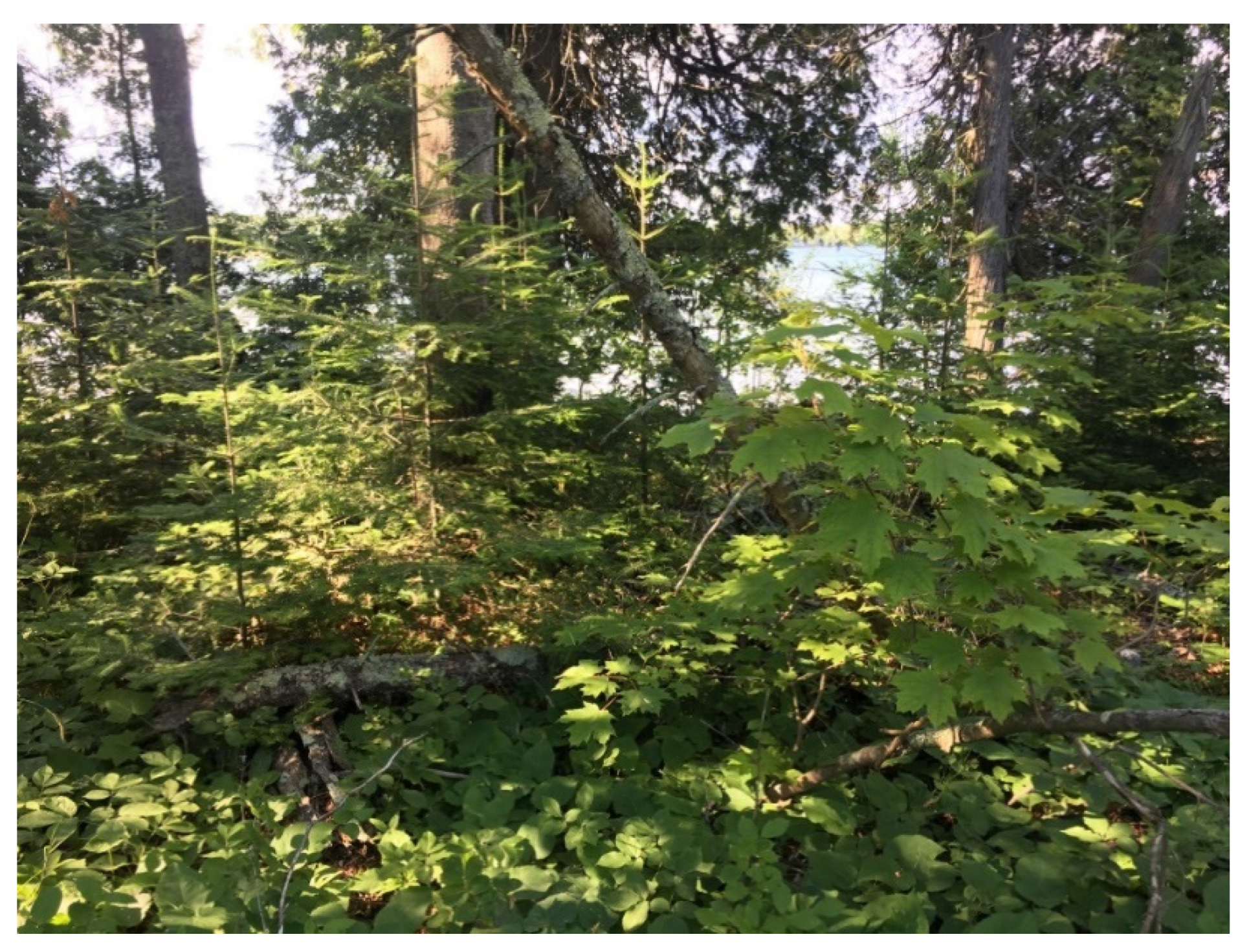
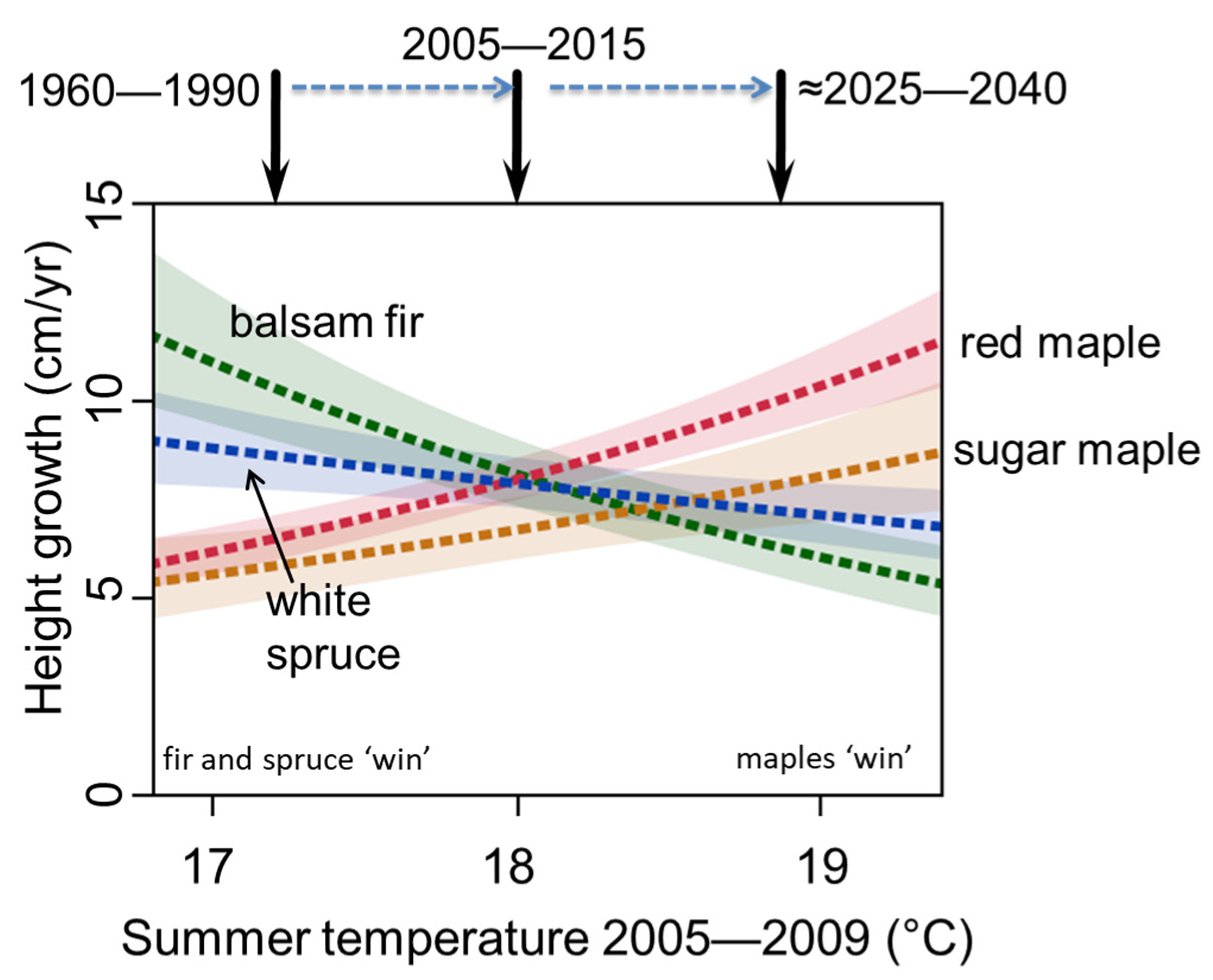

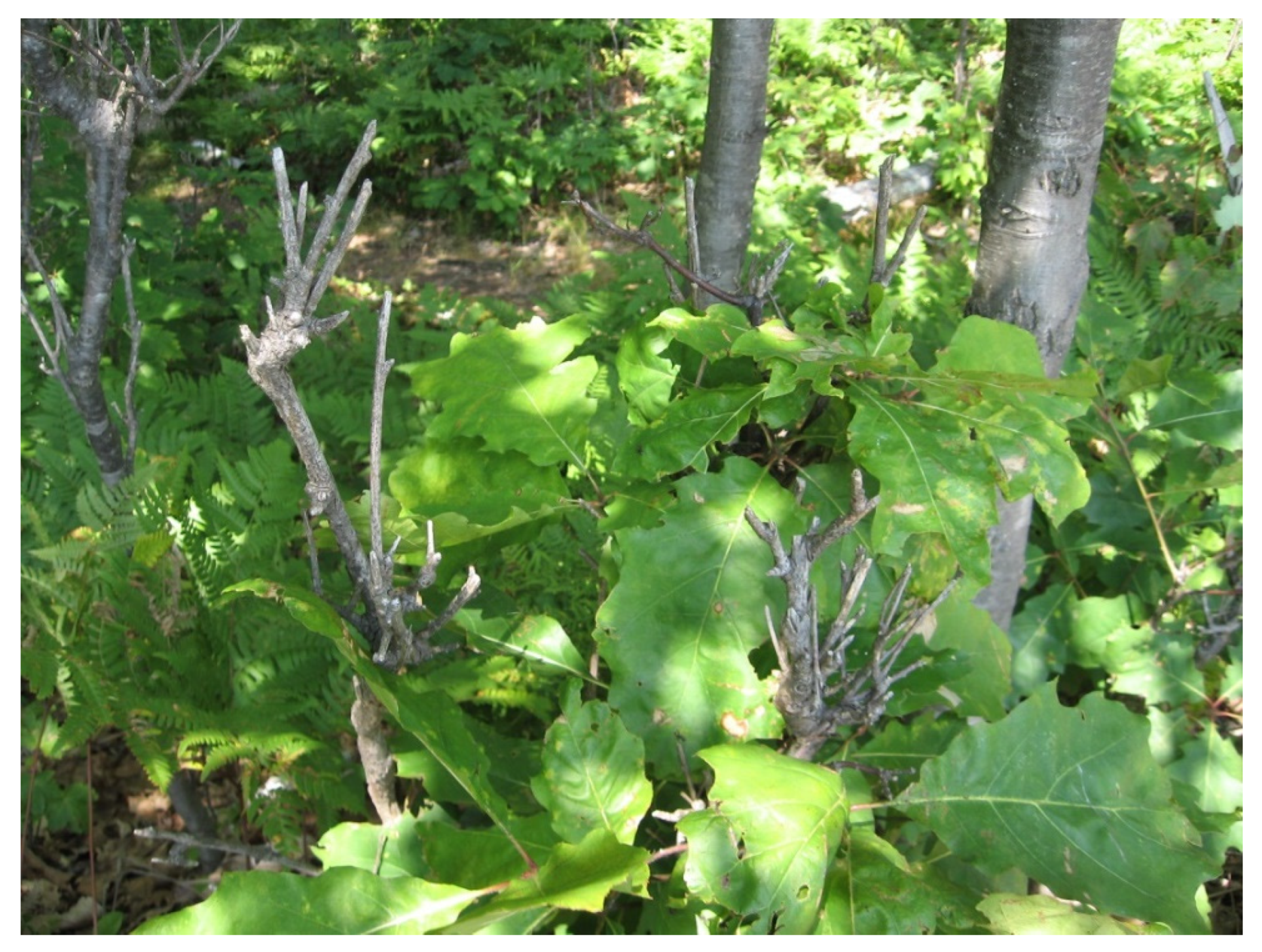
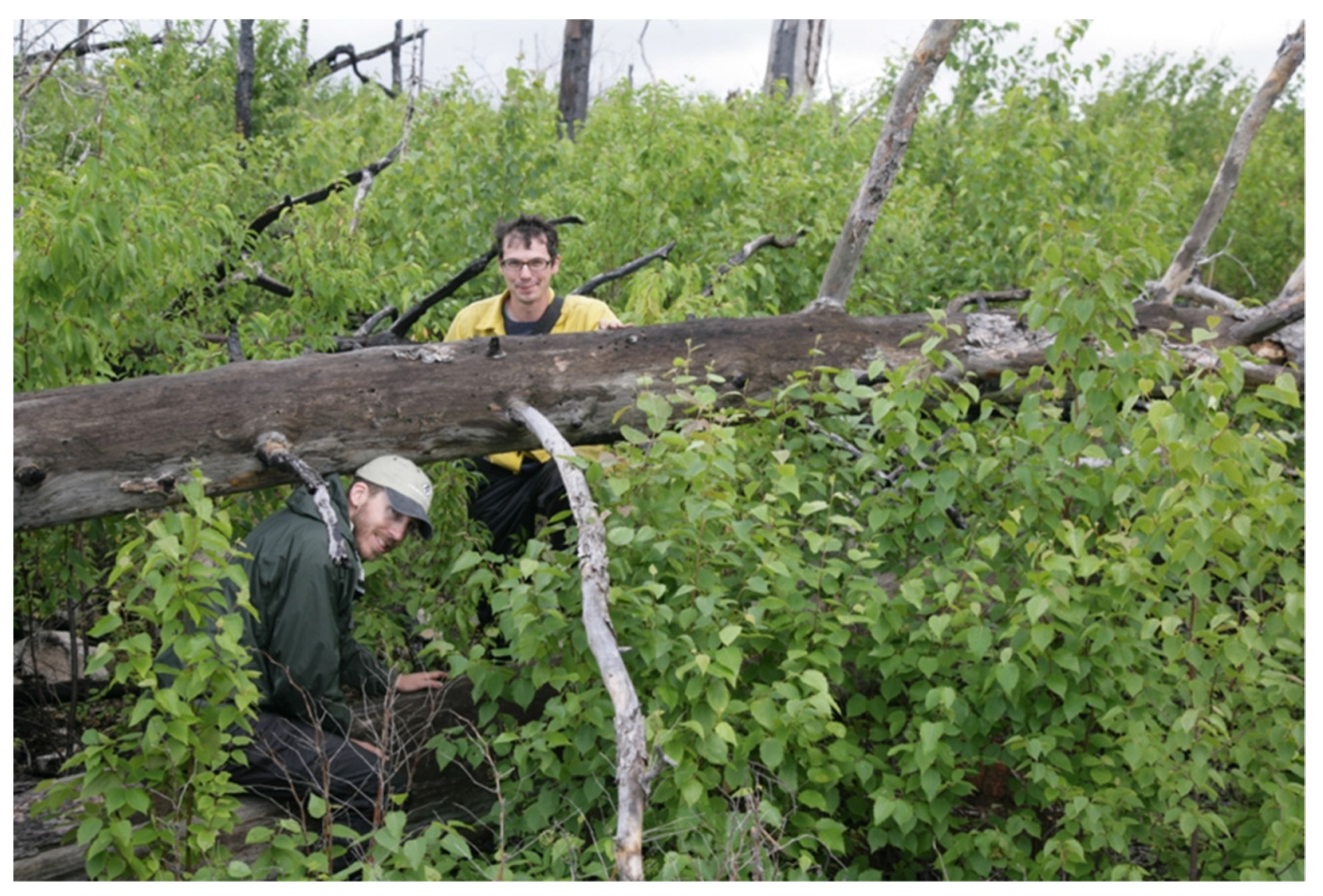
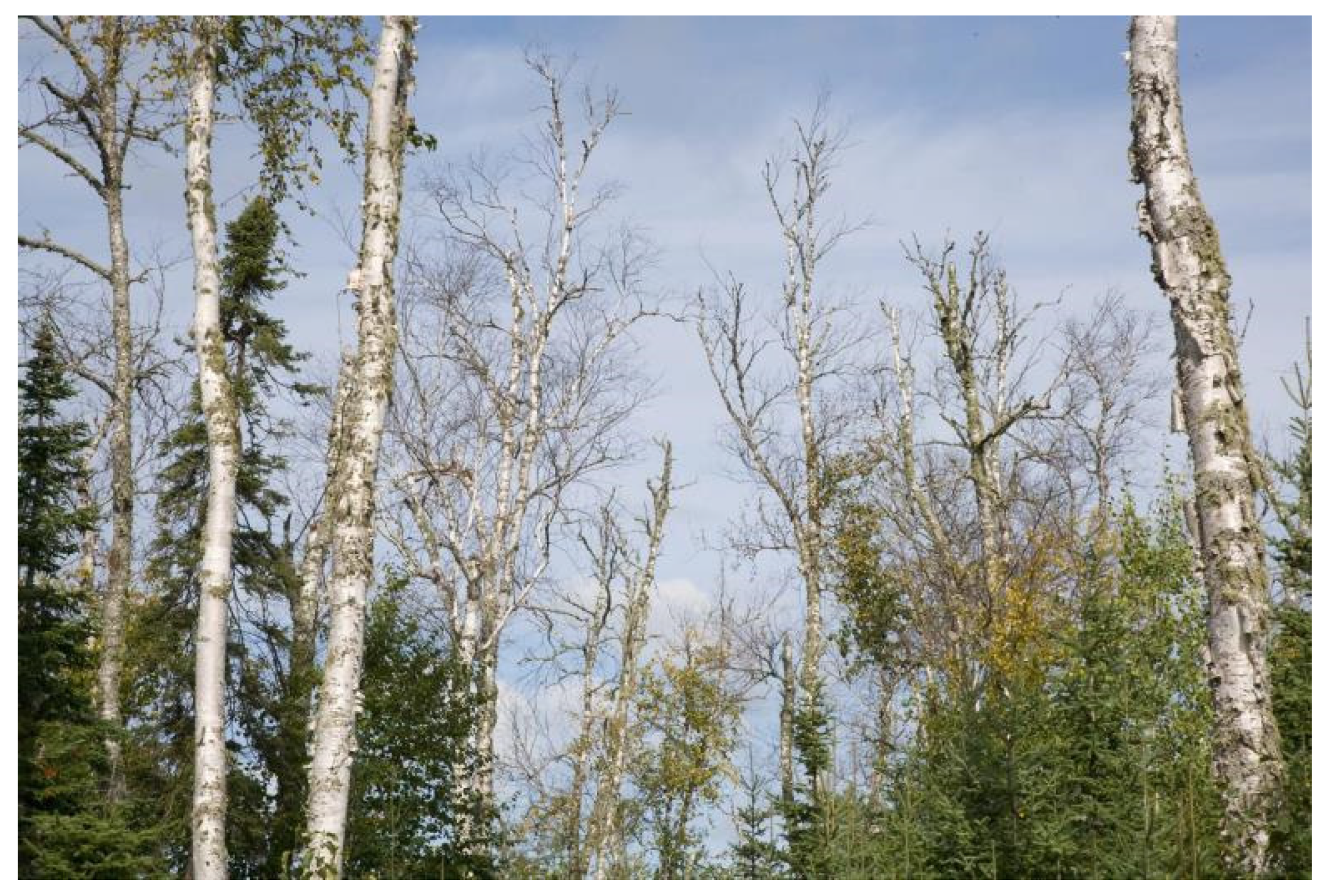

Publisher’s Note: MDPI stays neutral with regard to jurisdictional claims in published maps and institutional affiliations. |
© 2021 by the authors. Licensee MDPI, Basel, Switzerland. This article is an open access article distributed under the terms and conditions of the Creative Commons Attribution (CC BY) license (https://creativecommons.org/licenses/by/4.0/).
Share and Cite
Frelich, L.E.; Montgomery, R.A.; Reich, P.B. Seven Ways a Warming Climate Can Kill the Southern Boreal Forest. Forests 2021, 12, 560. https://doi.org/10.3390/f12050560
Frelich LE, Montgomery RA, Reich PB. Seven Ways a Warming Climate Can Kill the Southern Boreal Forest. Forests. 2021; 12(5):560. https://doi.org/10.3390/f12050560
Chicago/Turabian StyleFrelich, Lee E., Rebecca A. Montgomery, and Peter B. Reich. 2021. "Seven Ways a Warming Climate Can Kill the Southern Boreal Forest" Forests 12, no. 5: 560. https://doi.org/10.3390/f12050560
APA StyleFrelich, L. E., Montgomery, R. A., & Reich, P. B. (2021). Seven Ways a Warming Climate Can Kill the Southern Boreal Forest. Forests, 12(5), 560. https://doi.org/10.3390/f12050560





